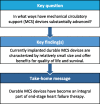Current perspectives on mechanical circulatory support
- PMID: 30608535
- PMCID: PMC6526098
- DOI: 10.1093/ejcts/ezy444
Current perspectives on mechanical circulatory support
Abstract
Mechanical circulatory support gained a significant value in the armamentarium of heart failure therapy because of the increased awareness of the prevalence of heart failure and the tremendous advances in the field of mechanical circulatory support during the last decades. Current device technologies already complement a heart transplant as the gold standard of treatment for patients with end-stage heart failure refractory to conservative medical therapy. This article reviews important aspects of mechanical circulatory support therapy and focuses on currently debated issues.
Keywords: Biventricular assist device; Left ventricular assist device; Mechanical circulatory report; Total artificial heart.
© The Author(s) 2019. Published by Oxford University Press on behalf of the European Association for Cardio-Thoracic Surgery.
Figures


References
-
- Previato M, Osto E, Kerkhof PLM, Parry G, Tona F.. Heart transplantation survival and sex-related differences. Adv Exp Med Biol 2018;1065:379–88. - PubMed
-
- Miller LW, Pagani FD, Russell SD, John R, Boyle AJ, Aaronson KD. et al. HeartMate II Clinical Investigators. Use of a continuous-flow device in patients awaiting heart transplantation. N Engl J Med 2007;357:885–96. - PubMed
-
- Ponikowski P, Voors AA, Anker SD, Bueno H, Cleland JGF, Coats AJS. et al.; ESC Scientific Document Group. 2016 ESC Guidelines for the diagnosis and treatment of acute and chronic heart failure: the task force for the diagnosis and treatment of acute and chronic heart failure of the European Society of Cardiology (ESC) Developed with the special contribution of the Heart Failure Association (HFA) of the ESC. Eur Heart J 2016;37:2129–200. - PubMed
-
- Guenther SP, Brunner S, Born F, Fischer M, Schramm R, Pichlmaier M. et al. When all else fails: extracorporeal life support in therapy-refractory cardiogenic shock. Eur J Cardiothorac Surg 2016;49:802–9. - PubMed
-
- Schibilsky D, Kruger T, Lausberg HF, Eisenlohr C, Haller C, Nemeth A. et al. Impella 5.0 as a second-line mechanical circulatory support strategy after extracorporeal life support. Artif Organs 2016;40:909–16. - PubMed
Publication types
MeSH terms
LinkOut - more resources
Full Text Sources
Medical

